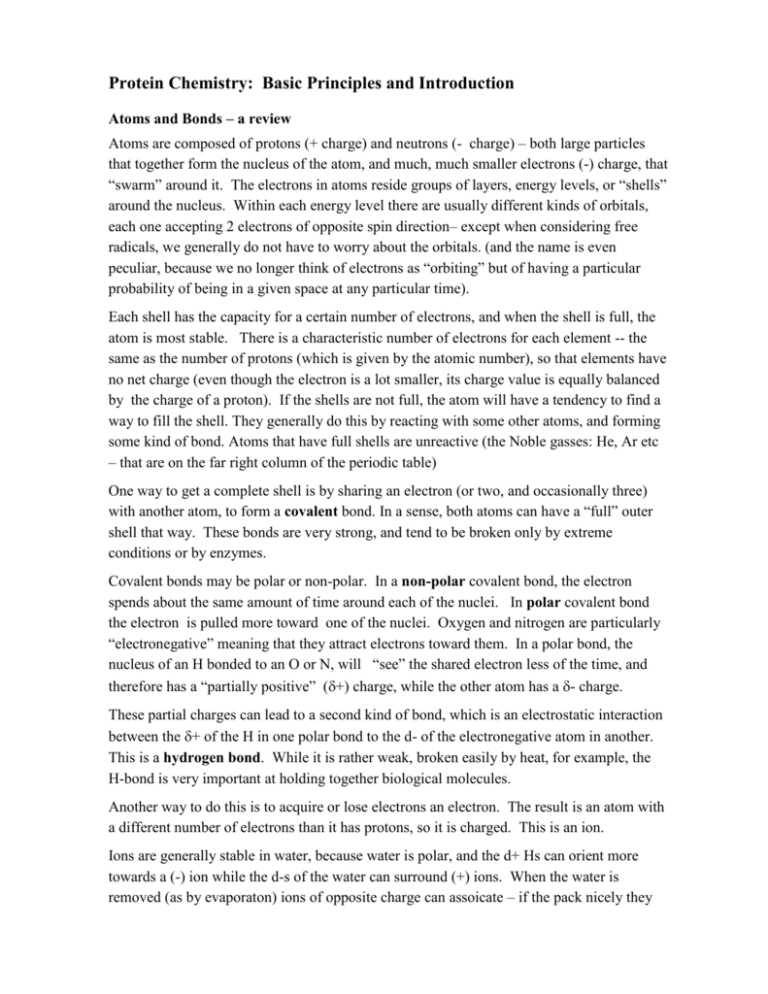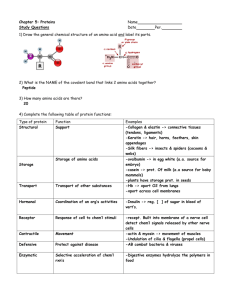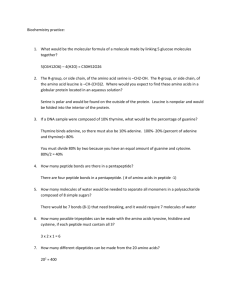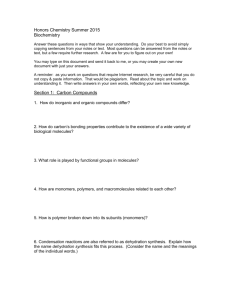Bonds – a review
advertisement

Protein Chemistry: Basic Principles and Introduction Atoms and Bonds – a review Atoms are composed of protons (+ charge) and neutrons (- charge) – both large particles that together form the nucleus of the atom, and much, much smaller electrons (-) charge, that “swarm” around it. The electrons in atoms reside groups of layers, energy levels, or “shells” around the nucleus. Within each energy level there are usually different kinds of orbitals, each one accepting 2 electrons of opposite spin direction– except when considering free radicals, we generally do not have to worry about the orbitals. (and the name is even peculiar, because we no longer think of electrons as “orbiting” but of having a particular probability of being in a given space at any particular time). Each shell has the capacity for a certain number of electrons, and when the shell is full, the atom is most stable. There is a characteristic number of electrons for each element -- the same as the number of protons (which is given by the atomic number), so that elements have no net charge (even though the electron is a lot smaller, its charge value is equally balanced by the charge of a proton). If the shells are not full, the atom will have a tendency to find a way to fill the shell. They generally do this by reacting with some other atoms, and forming some kind of bond. Atoms that have full shells are unreactive (the Noble gasses: He, Ar etc – that are on the far right column of the periodic table) One way to get a complete shell is by sharing an electron (or two, and occasionally three) with another atom, to form a covalent bond. In a sense, both atoms can have a “full” outer shell that way. These bonds are very strong, and tend to be broken only by extreme conditions or by enzymes. Covalent bonds may be polar or non-polar. In a non-polar covalent bond, the electron spends about the same amount of time around each of the nuclei. In polar covalent bond the electron is pulled more toward one of the nuclei. Oxygen and nitrogen are particularly “electronegative” meaning that they attract electrons toward them. In a polar bond, the nucleus of an H bonded to an O or N, will “see” the shared electron less of the time, and therefore has a “partially positive” (+) charge, while the other atom has a - charge. These partial charges can lead to a second kind of bond, which is an electrostatic interaction between the + of the H in one polar bond to the d- of the electronegative atom in another. This is a hydrogen bond. While it is rather weak, broken easily by heat, for example, the H-bond is very important at holding together biological molecules. Another way to do this is to acquire or lose electrons an electron. The result is an atom with a different number of electrons than it has protons, so it is charged. This is an ion. Ions are generally stable in water, because water is polar, and the d+ Hs can orient more towards a (-) ion while the d-s of the water can surround (+) ions. When the water is removed (as by evaporaton) ions of opposite charge can assoicate – if the pack nicely they will form crystals. NaCl is the classic example, but generally such compounds are called “salts”. When the crystals are put into water, the ions tend to dissociate, hydrated again. Some salts dissociate completely; some do not. Some salts are composed of two ionic species that are themselves covalent molecules. We will consider salts some more when we review pH, because acids are essentially salts in which the (+) ion is H+. Because of dissociation, acids increase the concentration of free H+ in the solution, which is then able to go interact with other molecules that might bind it. Protein structure Proteins are made up of amino acids. Amino acids have a backbone structure that is N – C – C The N is part of an amino group, NH2 (or NH3+, if it is protonated) The C on the other end is part of a carboxylic acid group: COO- (or COOH, if protonated) The center, or -carbon, is covalently linked to one of 20 different “R” groups (thus, 20 different amino acids – more on that later) Protein chains are constructed by the formation of a bond between the amino group of one amino acid, and the carboxyl group of a second (a peptide bond). A chain of amino acids connected by peptide bonds is called a polypeptide. The more general term “protein” may be used to imply function or as a descriptive term for this class of molecule. The R groups hang off the chain, and provide the variety of functional groups that give each protein its unique structure and function. – it is chemical nature of the R groups dictate the folded structure of the protein (its conformation) and its interactions with other molecules. That is why a protein is most fundamentally characterized by the order of the amino acids in the chain, which is called its primary structure. Because NH and OH of the peptide backbone are polar, H-bonds may form along the chain in a way that is mostly independent of what the R groups are. This is the basis for toe two main kinds of secondary structure. These are the -helix and the -pleated sheet. These structures provide multiple H-bond that help to hold the protein in its preferred, or native, conformation (that is, tertiary structure). The R groups contribute to stabilizing the overall folding, or conformation, of the protein becuase there are many ways that the groups can interact with each other. In addition, the R groups are involved in the interactions that proteins make with other molecules. The basic amino acids are those that tend (+) charged at neutral pH. These are arginine (arg), lysine (lys) and histidine (his) they may lose their protons at higher pH, becoming uncharged. The acidic amino acids, glutamate (glu) and aspartate (asp) tend to be (-) charged at neutral pH. They may pick up protons at lower pH to become uncharged. Acidic and basic amino acids can form salt bridge with each other, if they are charged (which is one reason that pH can affect structure). Some of the R groups are polar. This means that there will be some + Hs that will be able to form H-bonds with other atoms that are - because they are in other polar bonds. These can be within the molecule or between the protein and another molecule (a substrate, or hormone, or another protein molecule) Some of the R groups are non-polar. These groups tend to avoid water (hydrophobic) – it's because H2O tends to form somewhat organized “cages” around hydrophobic molecules, and this energetically unfavorable (recall that the second law of thermodynamics is that entropy, or disorder, tends to increase, and thus high disorder is linked with lower free energy). For proteins that are soluble in water, the folded conformation of the chain often puts the non-polar amino acids in the center of the molecule, near other non-polar groups, with water excluded. In membrane proteins, the opposite occurs, and hydrophobic groups are external, but embedded in the hydrophobic part of the lipid bilayer. Some proteins have hydrophobic faces on the outside – which may be energetically unfavorable, but critical to the protein’s ability to interact with other molecules. And protein folding can change – an example is calmodulin, a small protein that is quite soluble in water, but when it binds to Ca++ undergoes a conformational change that exposes a hydrophobic surface. This allows it to interact with hydrophobic patches on other molecules, usually to activate them. In addition to belonging to one of these four groups, some of the amino acids have other interesting properties. Cysteine (cys) has a sulfhydryl group (-SH ) that can combine with another –SH group to form a disulfide bond --S-S--. This is a covalent bond, rather difficult to break (except with fairly high concentrations of reducing agents). Disulfide bonds can be between with in a chain (intrachain) to hold two parts of the polypetide together, or between molecules (interchain). For example, disulfide bonds hold the 4 polypeptides chains of immunoglobulin (antibody) molecules together. Phenyalanine (phe) and tyrosine (tyr) have rings that absorb electromagnetic radiation in the UV range. Thus, we can roughly quantitate proteins by measuring the absorbance of light at 280 nm. The rings also provide special properties for other interactions. Proline has a structure that enforces an odd angle in the peptide backbone. Proline can break an alpha helix. It should be clear that the primary structure, or order of amino acids, of a polypeptide will ultimately drive the specific folded conformation of the protein, as well as its interaction with other molecules, and its function.







